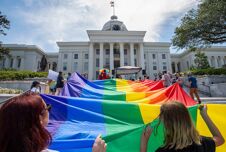Since RuPaul’s Drag Race stormed onto the scene in the early 2010s, fierce drag queens have captivated our attention both in bars and on screens – and no drag event has become quite as popular as Sunday brunch.
While it feels like scrambled eggs and sequins are very much a post-millennium combination, drag brunch – or a version of it – has been around for decades.
Related:
These historic queer tales paved the way for modern LGBTQ+ Hispanic literature
Gay themes and characters were harder to find in early Spanish and Latin American literature. Here’s where they were hiding…
“The history [of drag] is vast and complex and goes back thousands of years,” Simon Doonan, fashion commentator and author of Drag: The Complete Story, told LGBTQ Nation.
Never Miss a Beat
Subscribe to our newsletter to stay ahead of the latest LGBTQ+ political news and insights.
“The current iteration of drag has dotted lines to a variety of influences and venues including bawdy Victorian Music Halls, the Harlem ‘pansy’ craze, Weimar German cabaret, boozy British pubs, tassel-twirling American burlesque, Parisian follies and mid-century pageants, and yes, Monty Python.”
“Drag has provided a focal point and a catalyst for gay gathering spots for as long as I can remember, and I am over seventy!”
So, what’s the real history behind drag brunches exploding across the US?
America’s first drag artists
One of the earliest known drag performers in the US was William Dorsey Swann, a formerly enslaved person who became well-known around Washington DC for throwing lavish private balls. Swann’s male guests were described after a police raid in January 1887 as wearing “corsets, bustles, long hose and slippers”.
By the turn of the 20th century, drag was becoming a popular feature on the vaudeville circuit, a theater style featuring multiple acts, from magicians to comedians to singers to jugglers. The format remained popular until the 1930s.
One of the most prominent female impersonators on the scene was Julian Eltinge, a performer still thought to haunt New Orleans restaurant Tujague’s, a joint known for pioneering “second breakfast” in the 1860s.
The emergence of “drag-and-dine” experiences
According to experts, drag performances during mealtimes began around the mid-century, despite anti-crossdressing laws that persisted in America until decades later.
“Drag and meals have been associated since at least the 1950s,” Joe E. Jeffreys, a drag historian teaching at New York University and The New School, told LGBTQ Nation.
“Nightclubs like the 82 Club in NYC offered lavish drag shows to primarily heterosexual audiences and did serve food.”
The New York Historical Society has explained that “at a time when crossdressing was illegal, management didn’t want any trouble on the street outside that could disrupt the experience.” As such, they marketed drag shows as “dinner theater” and catering to straight audiences in an attempt to avoid police raids targeting LGBTQ+ venues.
Performers and staff would reportedly go to and from 82 Club dressed in clothing that matched their gender and only switch when they arrived at work.
As time went on and anti-crossdressing laws were overturned, more drag venues arrived on the scene. Iconic San Francisco restaurant Hamburger Mary’s opened in 1972, followed by New York spots Lucky Cheng’s and Lips, all offering food alongside cabaret performances, paving the way for drag brunch as we know it.
Experts claim actual drag brunches emerged in the 1980s, around the same time brunch itself was becoming a trend in the US – though the beloved weekend phenomenon didn’t achieve peak popularity until much later.
Doonan explained that as brunch rose in popularity, some bars added drag performances to attract the “pink dollar.”
“The ‘pink’ dollar has always had a huge impact on culture. The rise of disco venues in the 70s is a great example,” Doonan said.
“Bar owners realized that the audience – nursing a hangover and knocking back a bloody Mary – would stay longer and spend more money if drag was in the mix. These developments help increase LGBTQ+ cohesion and, most importantly, augment the incomes of drag queens.”
New York-based drag queen Marti Gould Cummings, who has performed in the city since 2008, claimed drag brunch opened a new avenue for artistic expression and said performing during the daytime is “an entirely different vibe than doing a nightclub show”.
“[Brunch] shows tend to attract families and people who may not be old enough to get into a club or just want something more chill,” they told LGBTQ Nation.
“I really enjoy the brunches because as a drag performer you can do different material than you would in a nightclub and expand yourself as an artist for a whole new audience demographic.”
Drag brunch as we know it
Jeffreys explained that while drag and dining have gone hand-in-hand for decades, drag brunch “began to appear and popularize” in the mid-2000s. He Attributed the current boom in part to RuPaul’s Drag Race.
“Audiences of the hit reality show wanted to see live drag performance but were thwarted by the time or place drag performance often occurs – late at night in bars,” he said
According to Jeffreys, it may feel like drag is just now enjoying its cultural peak, but it has in fact “always been mainstream”, from the “heyday” of vaudeville to movies like Some Like It Hot and Tootsie. RuPaul’s Drag Race simply catapulted the art form “back into larger cultural consciousness” in the 2010s.
“This has led to many more opportunities for all drag performers through the diversification of the typical late-night bar drag show form to the popularization of all sorts of events like drag brunches, drag bingos and drag story hours,” he said.
Jeffreys added that due to its subversive nature that overturns “societal dress code and behavioral standards”, drag will always “simultaneously have both a mainstream expression and a thriving underground scene”.
The future of drag brunch
While drag is currently enjoying enormous success, both mainstream and underground, the scene is facing a litany of challenges, from attacks by far-right protesters to anti-drag legislation to a nationwide loss of queer venues.
According to a 2022 study, the number of LGBTQ+ bars in the US declined by around 15% between 2019 and 2021, while bars specifically serving LGBTQ+ people of color declined by nearly 24%.
Despite this loss, drag queens and the wider LGBTQ+ community are fighting to protect their spaces, with initiatives like The Lesbian Bar Project, mainstream venues like Taco Bell hosting drag brunch, and even the record-breaking biggest drag brunch in history, with 412 attendees.
“With an incredible amount of anti-LGBTQ+ legislation being introduced and the right-wing attacking, drag allies need to be vocal,” Cummings said. “Not only is drag under attack, but our transgender community and non-binary communities are severely under attack… Allies must show up, counter-protest, be vocal, vote and protect.”
Drag has thrived through decades of prejudice, and experts say it will continue to act as a joyful expression of queer culture.
“Drag events like Drag Story Hours have been picketed and had bomb threats called… there have always been laws against crossdressing and resistance to it,” Jeffreys said.
“Drag must and will go on, and the path is to keep doing it with all the joy, creativity and dedication that can be mustered.”
















